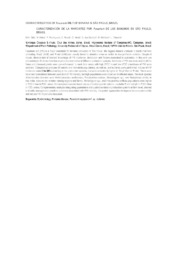Characterization of Fusarium wilt of banana in São Paulo, Brazil.
Characterization of Fusarium wilt of banana in São Paulo, Brazil.
Autoria: RODRIGUEZ, M. A. D.; VIEIRA, H. B.; RODRIGUES, F.; ROSSI, C.; HECK, D. W.; SANTOS, A. dos; MORAES, W.; TEIXEIRA, L. A. J.
Resumo: Fusarium wilt (FW) is a major constraint for banana production in São Paulo, the biggest banana producer in Brazil. Farmers cultivating ?Maçã? (AAB) and ?Prata? (AAB) (AAB) are usually forced to abandon areas or switch to less profitable varieties. Despite it impact, there is lack of detailed knowledge of FW incidence, distribution and factors associated to epidemics. In this work we characterized 20 farms from four regions representative of different production systems. Incidence of FW was evaluated in all the farms and diseased plants were geo-referenced. In each farm areas with high (FOC +) and low (FOC-) incidence of FW were selected. Comparative analyses of weevils and nematode populations, as well as, soil nutrients were performed. Values of FW incidence varied 2 to 38% according to the production systems, but were consistently higher in ?Maçã? than in ?Prata?. There were no a clear correlations between weevils and FW intensity, but high populations were observed in infected areas. The main species of nematodes detected were Helicotylenchus multicinctus, Pratylenchus coffeae, Meloidogyne spp. and Radopholus similis, in this order. Despite the variation among regions and farms, Meloidogyne spp. and Pratylenchus coffeae populations were higher in FOC+ than in FOC- areas. Soil analyses revealed lower values of exchangeable calcium, available P and soil pH in FOC+ than in FOC- areas. Complementary analyzes integrating quantitative and qualitative data on production systems at farm level, allowed to identify management practices putatively associated with FW intensity. Integrated approaches to improve banana productivity and reduce FW impact are discussed.
Ano de publicação: 2017
Tipo de publicação: Resumo em anais e proceedings
Unidade: Embrapa Meio Ambiente
Palavras-chave: Fusarium oxysporum f sp cubense, Panama disease, epidemiology
Observações
1 - Por padrão são exibidas publicações dos últimos 20 anos. Para encontrar publicações mais antigas, configure o filtro ano de publicação, colocando o ano a partir do qual você deseja encontrar publicações. O filtro está na coluna da esquerda na busca acima.
2 - Para ler algumas publicações da Embrapa (apenas as que estão em formato ePub), é necessário ter, no celular ou computador, um desses softwares gratuitos. Sistemas Android: Google Play Livros; IOS: iBooks; Windows e Linux: software Calibre.
Acesse outras publicações
Acesse a Base de Dados da Pesquisa Agropecuária (BDPA) para consultar o acervo completo das bibliotecas da Embrapa.

